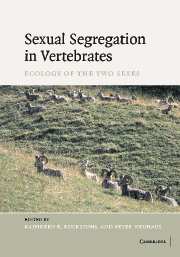Book contents
- Frontmatter
- Contents
- List of contributors
- Preface
- Part I Overview
- Part II Concepts and methodology
- Part III Foraging ecology
- Part IV Predator avoidance and reproductive strategies
- 7 Predation risk as a driving factor for size assortative shoaling and its implications for sexual segregation in fish
- 8 Differences in habitat selection and reproductive strategies of male and female sharks
- 9 Sex differences in reproductive strategies affect habitat choice in ungulates
- Part V Sex-related activities and social factors
- Part VI Sexual differences in ecology: comparisons within different taxa
- Part VII Implications for conservation
- Part VIII Outlook
- References
- Index
7 - Predation risk as a driving factor for size assortative shoaling and its implications for sexual segregation in fish
Published online by Cambridge University Press: 04 September 2009
- Frontmatter
- Contents
- List of contributors
- Preface
- Part I Overview
- Part II Concepts and methodology
- Part III Foraging ecology
- Part IV Predator avoidance and reproductive strategies
- 7 Predation risk as a driving factor for size assortative shoaling and its implications for sexual segregation in fish
- 8 Differences in habitat selection and reproductive strategies of male and female sharks
- 9 Sex differences in reproductive strategies affect habitat choice in ungulates
- Part V Sex-related activities and social factors
- Part VI Sexual differences in ecology: comparisons within different taxa
- Part VII Implications for conservation
- Part VIII Outlook
- References
- Index
Summary
OVERVIEW
Fish shoals have been fundamental in developing our understanding of the evolution of sociality (see Krause & Ruxton, 2002). They have been used in a range of laboratory and field studies, and have been particularly useful in investigating the adaptive significance of the phenotypic assortment of social groups (see Krause et al., 2000a for a review). In particular investigations on fish shoals have elucidated the mechanisms underlying assortment by body size (Krause et al., 2000b; Croft et al., 2003). However, in contrast to mammals (mainly ungulates) fish have largely been neglected from the literature on sexual segregation (see Sims et al., 2001a; Croft et al., 2004 for exceptions).
Sexual segregation is often associated with sex differences in body size (see Ruckstuhl & Neuhaus, 2000, 2002 for a review in ungulates – see also Chapter 10). In such cases, segregation by body size will automatically result in segregation by sex. Body size differences, however, are not restricted to sexual dimorphism but often found within the sexes as well. Thus, by understanding the mechanisms underlying body size assortment we may better understand a more general phenomenon that includes sexual segregation.
Group living is an important anti-predator strategy (Hamilton, 1971; Krause & Ruxton, 2002), consequently predation risk is a strong selective force influencing the composition of social groups. Initially, we examine the anti-predator benefits of the phenotypic and behavioural assortment of social groups in fish, paying particular attention to assortment by body length.
- Type
- Chapter
- Information
- Sexual Segregation in Vertebrates , pp. 115 - 126Publisher: Cambridge University PressPrint publication year: 2006
- 1
- Cited by



